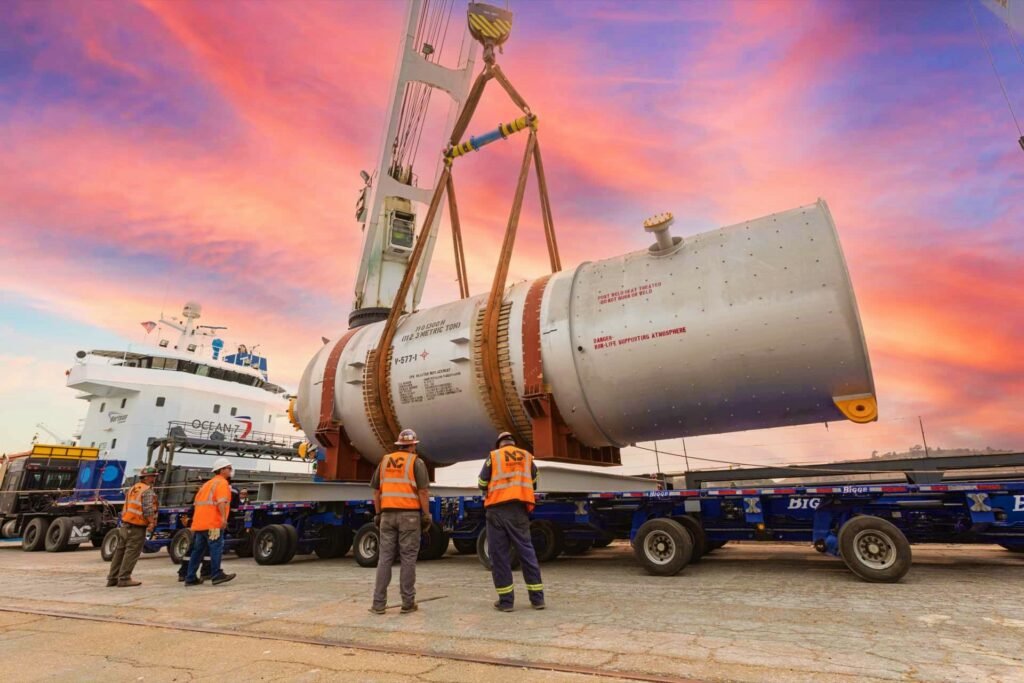
Mastering the Art of Rigging:
Rigging is one of the most important parts of any construction project. If it’s done incorrectly, the entire process can become dangerous for everyone involved. Equipment riggers are responsible for designing and installing the equipment that will move large machinery, structural components, or building materials on construction and industrial sites. Learn about the different types of rigging that exist below:
Industrial Rigging
Industrial rigging plays an essential role in projects in several industries, including construction, manufacturing, mining, and oil and gas. It’s also used in the aerospace industry to move heavy equipment to and from different sites.
Riggers use a variety of tools and techniques to safely and efficiently transport heavy equipment and machinery. They have a strong understanding of a load’s center of gravity and how to determine the maximum load a crane can handle. They work with crane operators to ensure the load is properly loaded, balanced, and secured.
When choosing a rigging company for your project, you’ll want to consider the company’s years of experience, scope of projects, and industry expertise. A reputable and reliable rigging contractor will provide the knowledge, manpower, and equipment to handle your specific project needs.
When shipping industrial rigging equipment, there’s no room for error. The right transportation company can make all the difference in ensuring your equipment arrives at its new home safe and sound. They’ll help you navigate the process from start to finish, providing a wide range of services from packing and crating to preparing and documenting the shipment for transit.
Construction Rigging
Construction riggers make it their business to ensure it is positioned correctly loads and securely before cranes lift them into the air. They know how to calculate the dimensions of a load, its center of gravity, and a sufficient number of approved lifting points. They also understand the limitations of a crane’s hoisting equipment and how to use it safely.
They are familiar with the specs of all types of construction machinery and have an in-depth knowledge of how each piece of rigging equipment works. This includes knowing what capacities to expect from each type of hitch, and understanding how sling angles affect tension and standard hand signals. They can help a crew plan out hoisting operations, secure necessary permits and zoning, manage risks, and operate all machinery.
Riggers are often called upon to move a wide range of items, from delicate MRI machines to hydroelectric dam generators. No matter the project, construction riggers are always prepared to work efficiently and safely. Their expertise helps reduce the risk of accidents and damage, which can cost thousands of dollars to repair or replace, and can even put lives at stake.
Entertainment Rigging
Entertainment rigging involves the putting up and taking down of stage equipment such as lighting, sound projection, video screens, cameras, etc. for events like concerts, theatrical shows, and other live events that include a stage.
Rigging in the entertainment industry demands great expertise and knowledge of safety. This includes a deep understanding of how different types of trusses and rigging work as well as how to properly design and allocate equipment. It is crucial to ensure that any rigging setup used at an event is safe, as it can be dangerous for performers, audience members, and rigging staff if the setup doesn’t meet the necessary standards.
Moreover, the importance of entertainment rigging lies in its ability to create an impressive, immersive environment for the audience at a live performance. A good theatrical show should tell a story that transports the audience and makes scenery changes appear effortless. This is impossible without a solid rigging system in place. Rigging systems hide equipment from the audience and help mask any unused sets or scenes, so the focus is on the performance.
Marine Rigging
Riggers use a complex network of lines, pulleys, and fasteners to secure masts and sails. They also hoist cargo, equipment, and structures using a variety of equipment such as cranes, derricks, and winches. Riggers must perform quick load calculations and follow strict safety protocols when working at heights.
In the marine industry, riggers may work on steam and motor ships as well as private yachts. Marine riggers are often responsible for operating rigging equipment and loading materials and cargo onto ships and offshore platforms. They must take care to ensure that all cargo is secured properly to avoid dropping cargo which can cause injury to riggers and damage to the ship and its cargo.
Specialized Rigging Solutions
Rigging projects require specialized equipment and expertise. Engaging in rigging without the proper knowledge, skills, and equipment can result in significant damage to machinery or personal injury. Choosing the right rigging company for your project is crucial to ensure it’s completed on time and within budget without any incidents.
Riggers know how to calculate the size of the connections required for a lift, select the appropriate slings to secure the load, and control it as it’s raised by a crane. They also know how to navigate through confined spaces and can use different types of rigging hardware including chokers, shackles, long-reach shackles, slings and wire ropes.
